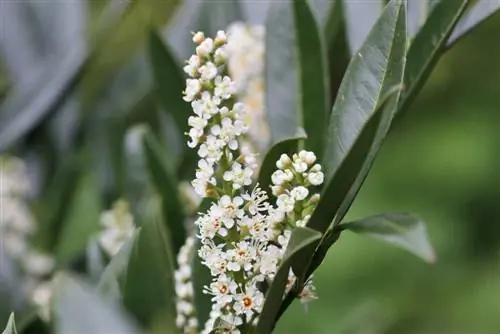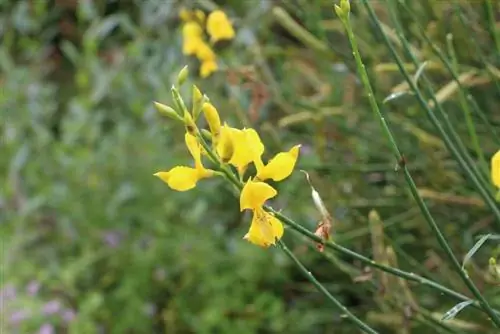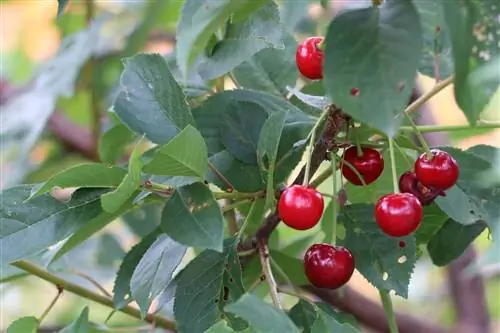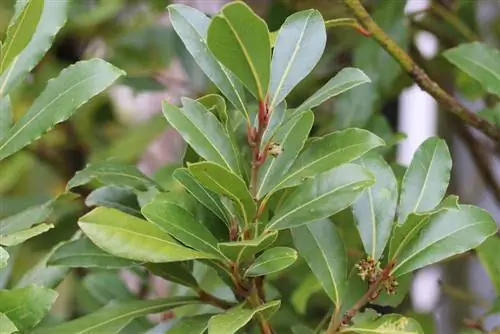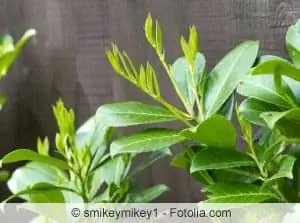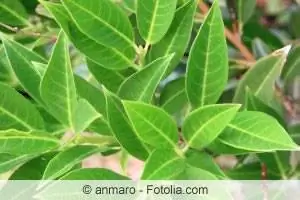- Author admin [email protected].
- Public 2023-12-17 03:39.
- Last modified 2025-01-24 12:45.
Small and spreading, round or tall - the cherry laurel is fundamentally differentiated according to its shape and therefore its intended use in the garden. It is precisely these shapes that can provide an indication of the winter hardiness of the plant. When making your selection, you should pay attention to whether the cherry laurel in question is suitable for the respective winter climate.
Small and spreading
Small and spreading forms of cherry laurel have limited height growth and therefore various advantages. These include:
Use as ground cover
Due to their low and wide growth, they can be used as ground cover and can be used to green larger areas.
Low altitude, greater winter hardiness
Due to the low altitude, the plants are hardly exposed to cold wind. In winter it is therefore less sensitive and can withstand colder temperatures well. Separate protection is therefore not necessary.
Free choice of location
Due to their greater winter hardiness, the wide-growing cherry laurel varieties are also suitable for exposed areas and do not have to be planted in protected areas or cultivated in pots.
Round cherry laurel
As the name suggests, the round cherry laurel grows in a rounded shape. However, it is not just the growth habit that distinguishes it from the other cherry laurel varieties. There are also the following properties and factors:
Height
The round cherry laurel grows slightly higher than the ground-covering varieties. As a rule, the plants grow to be at least one meter high, but usually higher.
Cutting tolerance
The round cherry laurel is easy to cut and can therefore be easily shaped into the desired shape.
Varying hardiness
In contrast to the short and spreading cherry laurel varieties, not every cultivated form of the round cherry laurel is well winter-hardy. In addition, its height means it is more exposed to the cold wind. In regions with particularly cold winters, you should therefore consider whether to cultivate the plant in a container. Alternatively, particularly resistant breeds can also be chosen. If these are also covered on the ground with mulch and brushwood, the risk of frost damage can be reduced even further.
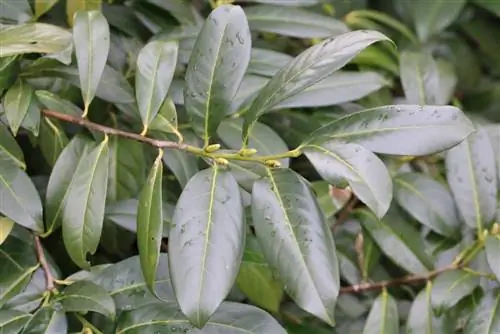
From solitaire to hedge
Due to their height and shape, round cherry laurel varieties can be used as solitary plants but can also form low hedges.
Upright varieties
Tall and upright growing cherry laurel varieties are ideal as hedge plants. However, due to their growth habit, they also have some special features when it comes to overwintering. These include:
Frost sensitivity
The upright-growing varieties are the most sensitive of all growth forms to cold wind and frost. On the one hand, this is because they are more exposed to temperatures than the lower versions. As a hedge, they offer each other a certain amount of protection. However, in particularly cold regions this is not always enough.
Necessary winter protection
In colder regions, mulch, brushwood, leaves or straw should be applied to the soil around the cherry laurel plants. If there are very cold winds, it may also make sense to cover the plants lightly with special plant fleece. However, the plants should not be wrapped so that they are permanently darkened. Because this can also cause them damage.
Winter-hardy varieties
In order to avoid culture in the bucket, suitable varieties with greater winter hardiness should be chosen. Even then, it can make sense to add additional winter protection.
Winter-hardy variants
Every cherry laurel is conditionally hardy. In regions with very mild winters, it is not necessary to pay special attention to which varieties are planted. The additional protection provided by covering the soil and plants is also not absolutely necessary. However, the measures can make sense if a hard and long winter is expected.
If cherry laurel is to be cultivated in colder regions, the following varieties are recommended:
- Cherry Laurel Caucasica
- Cherry Laurel Cherry Brandy
- Cherry Laurel Herbergii
- Cherry laurel Otto Luyken
- Cherry Laurel Genolia
These are particularly hardy and are therefore also suitable for unprotected areas and particularly low temperatures.
Frost Damage
The evergreen cherry laurel can show frost damage without freezing or dying directly. This is frostbite on the leaves. The leaves turn yellow to brownish and subsequently fall off. Individual shoots and branches can also freeze and die. As long as the damage is limited to small areas, it is harmless. In spring the dead plant parts can be cut off.
If large areas die off, the plant should be additionally protected. As mentioned, placing a layer on the ground and covering it with garden fleece can have an insulating effect and prevent more serious damage. On sunny and milder days, the fleece should be removed so that light can reach the leaves. If the winter is dark, damage and loss of leaves could also occur.
Wintering indoors
An alternative to choosing protected locations and particularly winter-hardy cherry laurel varieties is cultivating them in a bucket and overwintering them indoors. There are only a few points that need to be taken into account:
Sufficient light
Since the cherry laurel is an evergreen plant, it needs sufficient light even during wintering. A location near a window or at least a bright room is therefore important.
Correct temperature
A wintering temperature between 0 and 10°C is ideal. The room should be frost-free, but not heated. If temperatures are too high, the plant does not go into hibernation but continues to photosynthesize at a high level. However, the lighting conditions in winter are not sufficient for this. Overwintering that is too warm can therefore cause the cherry laurel to be damaged.

No fertilizer
The fertilization of the cherry laurel should be stopped in autumn. Since nutrient consumption and requirements decrease in winter, the soil could very quickly become over-fertilized and the roots could suffer chemical burns.
Low water
Even in winter, the cherry laurel gets water from the ground on frost-free days. When overwintering indoors, care should also be taken to ensure that the soil does not dry out completely.

